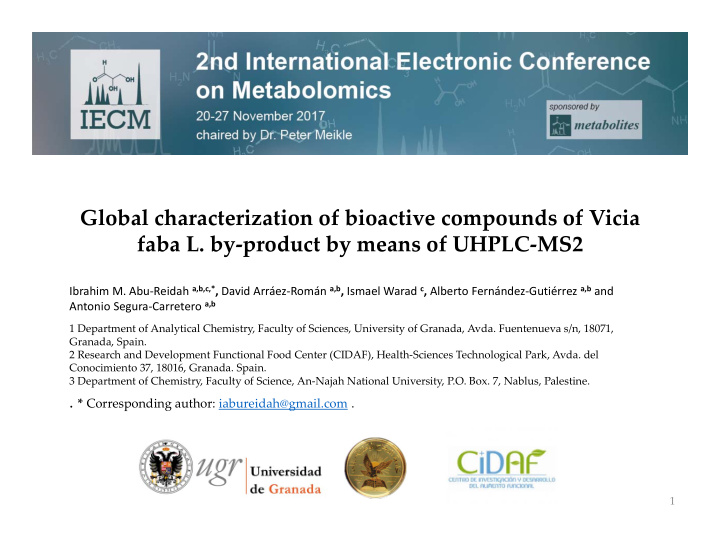



Global characterization of bioactive compounds of Vicia faba L. by ‐ product by means of UHPLC ‐ MS2 Ibrahim M. Abu ‐ Reidah a,b,c,* , David Arráez ‐ Román a,b , Ismael Warad c , Alberto Fernández ‐ Gutiérrez a,b and Antonio Segura ‐ Carretero a,b 1 Department of Analytical Chemistry, Faculty of Sciences, University of Granada, Avda. Fuentenueva s/n, 18071, Granada, Spain. 2 Research and Development Functional Food Center (CIDAF), Health ‐ Sciences Technological Park, Avda. del Conocimiento 37, 18016, Granada. Spain. 3 Department of Chemistry, Faculty of Science, An ‐ Najah National University, P.O. Box. 7, Nablus, Palestine. . * Corresponding author: iabureidah@gmail.com . 1
Title of the Presentation Vicia fava pods 2
Abstract: Currently, by ‐ products produced from the agro ‐ industries practices could be a key source of functional and bioactive components; which could be used due to their nutritional and added ‐ value properties. New aspects concerning the use of these wastes as by ‐ products in production of food additives or supplements have recently gained increasing interest. In this sense, the present study describes thorough characterization of phytochemicals from methanolic extract of broad beans pods by using high ‐ performance liquid chromatography linked with quadrupole ‐ time ‐ of ‐ flight tandem mass spectrometry. The utilized analytical technique provided the tentative identification more than 140 phenolic and other phytochemical compounds in the extract, most of which have not been described up to now in broad beans pods. Thus, more than 90 phytochemicals (phenolic acids, fl avonoids, iridoids, lignans, and terpenoids derivatives) are reported herein in broad beans pods for the fi rst time. The data obtained demonstrate that vegetal by ‐ product from the food industry could potentially be utilized as a promising source of bioactive ingredients to design new nutraceuticals and functional foods with a valued future market. Keywords: Broad bean ( Vicia faba L.); Food by ‐ products; Phenolics; flavonoids; UHPLC ‐ ESI ‐ qTOF ‐ MS 2 3
Introduction • Broad bean ( Vicia faba L.), is a species of bean family Fabaceae (Leguminosae), widely consumed in many countries for its edible seeds and pods. It is an important leguminous crop worldwide because of its nutrient ‐ rich seeds. It is largely used as a legume, a vegetable, and as fodder. • It is native to southwest Asia and North Africa Europe, the Middle East and extensively cultivated elsewhere. Besides, this vegetable has a long heritage of cultivation in old world agriculture, being among the most ancient plants in cultivation. • Broad bean is a prized diet component since it contains good contents of starch and proteins. Besides, it contains considerable amounts of other valuable nutrients: fiber, choline, lecithin, minerals, and secondary metabolites. Vicia faba is also termed as: fava bean (Faba bean), bell bean, field bean or tic bean. • Pulses (legumes) mostly are consumed after a prior industrial process, in which, seeds are separated from their pods by ‐ products to be prepared mainly as fresh, tinned, or frozen food. Successively, the big masses of by ‐ products generated during the plant food industry may represent economic and disposal problems due to their high volumes and elimination costs. • According to FAO estimations; world production of broad beans was estimated to be around 4 million tons. Curiously, the harvesting of this vegetable would yield around 2.8 millions of tons of broad bean by ‐ products (~70% of the total production). Whole immature pods have been long used as food and feed. 4
Introduction • The BBP form an abundant and inexpensive material which has been undervalued yet. Thus, it is of a great importance to know the phytochemical composition of those by ‐ products which could be used as a source of natural functional components. • Therefore, the goal of the present work has been to carried out an extensive characterization of the hydro ‐ methanolic extract from BBP by using UHPLC ‐ ESI ‐ qTOF ‐ MS 2 as a powerful separation and detection analytical technique. 5
Results and Discussion • In the present work 145 phytochemical compounds (mainly phenolic compounds) have been tentatively characterized in the BBP by using the combination of MS and MS2 data and related information previously reported in the literature. • Nearly 100 phenolic compounds, mainly flavonoids and their glycosylated ‐ forms, have been characterized, of which, 72 compounds are reported here in broad beans pods (BBP) for the first time. • In the present work, glycosylated flavonoids are the most common phenolic compounds found in the BBP. • Eight lignan derivatives have been identified in the hydro ‐ methanolic extract of BBP. Interestingly, these lignan derivatives. 6
Results and Discussion Ints. 6 Fig. 1 Base Peak Chromatogram together with x10 1.0 Density view window of broad beans pods by ‐ products 0.8 0.6 0.4 0.2 7
Results and Discussion (+)-Pinoresinol Fig. 2 Structure of some phytochemicals tentatively characaterized in broad bean pods 8
Conclusions • In the present work, a qualitative analysis of the phytochemical composition in an extract from BBP has been performed by using UHPLC-qTOF-MS 2 , which provided high resolution and mass accuracy which allowed the feasibility of chemical characterization of unknown phytochemicals. • Thus, by using the proposed method was supportive to detect and characterize 142 phenolic compounds, of which 91 have been tentatively characterized here for the first time in BBP which demonstrated that this matrix is a rich source of bioactive compounds. • The presence of this great amount of dietary phenolics and other phyto- components provides significant added value to these by-products and the possibility to enrich food according to nutritional requirements and also an advantage to use the broad bean extract as functional ingredients for the development of value added products and other food applications to boost health. • These results are useful to provide more value added and usefulness from this legume. 9
Acknowledgments 10
Recommend
More recommend